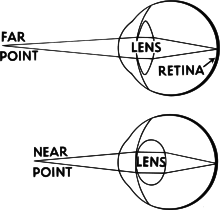

Accommodation is the process by which the vertebrate eye changes optical power to maintain a clear image or focus on an object as its distance varies. In this, distances vary for individuals from the far point—the maximum distance from the eye for which a clear image of an object can be seen, to the near point—the minimum distance for a clear image. Accommodation usually acts like a reflex, including part of the accommodation-convergence reflex, but it can also be consciously controlled.
The main ways animals may change focus are:
- Changing the shape of the lens.
- Changing the position of the lens relative to the retina.
- Changing the axial length of the eyeball.
- Changing the shape of the cornea.